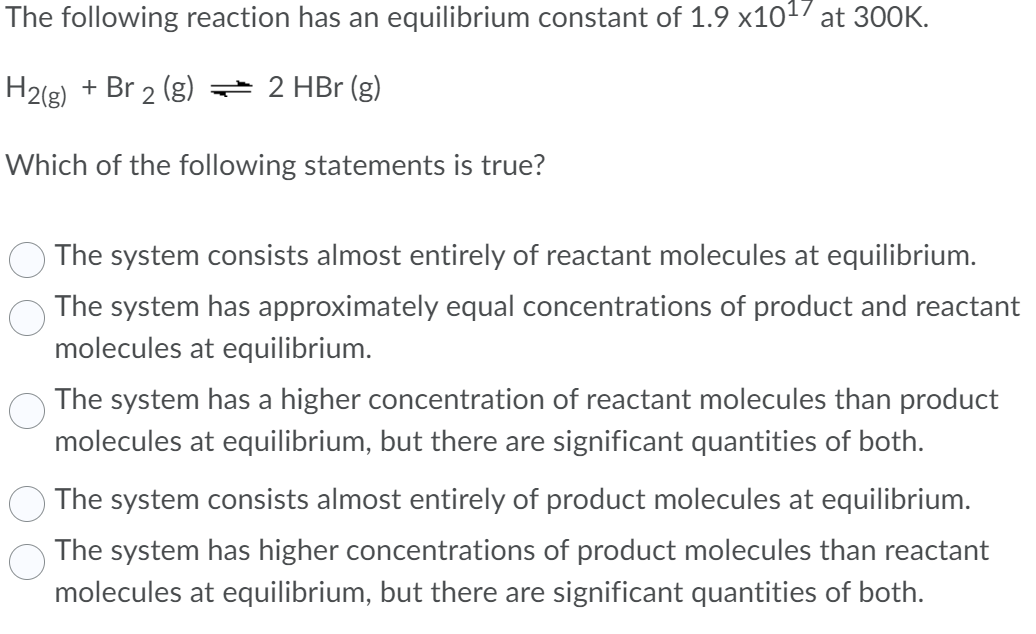The following reaction has an equilibrium constant of 1.9 x10¹7 at 300K. H2(g) + Br 2 (g) → 2 HBr (g) Which of the following statements is true? The system consists almost entirely of reactant molecules at equilibrium. The system has approximately equal concentrations of product and reactant molecules at equilibrium. The system has a higher concentration of reactant molecules than product molecules at equilibrium, but there are significant quantities of both. The system consists almost entirely of product molecules at equilibrium. The system has higher concentrations of product molecules than reactant molecules at equilibrium, but there are significant quantities of both.
The following reaction has an equilibrium constant of 1.9 x10¹7 at 300K. H2(g) + Br 2 (g) → 2 HBr (g) Which of the following statements is true? The system consists almost entirely of reactant molecules at equilibrium. The system has approximately equal concentrations of product and reactant molecules at equilibrium. The system has a higher concentration of reactant molecules than product molecules at equilibrium, but there are significant quantities of both. The system consists almost entirely of product molecules at equilibrium. The system has higher concentrations of product molecules than reactant molecules at equilibrium, but there are significant quantities of both.
Chemistry: The Molecular Science
5th Edition
ISBN:9781285199047
Author:John W. Moore, Conrad L. Stanitski
Publisher:John W. Moore, Conrad L. Stanitski
Chapter12: Chemical Equilibrium
Section: Chapter Questions
Problem 60QRT
Related questions
Question

Transcribed Image Text:The following reaction has an equilibrium constant of 1.9 x10¹7 at 300K.
H2(g) + Br 2 (g) → 2 HBr (g)
Which of the following statements is true?
The system consists almost entirely of reactant molecules at equilibrium.
The system has approximately equal concentrations of product and reactant
molecules at equilibrium.
The system has a higher concentration of reactant molecules than product
molecules at equilibrium, but there are significant quantities of both.
The system consists almost entirely of product molecules at equilibrium.
The system has higher concentrations of product molecules than reactant
molecules at equilibrium, but there are significant quantities of both.
Expert Solution
This question has been solved!
Explore an expertly crafted, step-by-step solution for a thorough understanding of key concepts.
Step by step
Solved in 2 steps with 2 images

Knowledge Booster
Learn more about
Need a deep-dive on the concept behind this application? Look no further. Learn more about this topic, chemistry and related others by exploring similar questions and additional content below.Recommended textbooks for you

Chemistry: The Molecular Science
Chemistry
ISBN:
9781285199047
Author:
John W. Moore, Conrad L. Stanitski
Publisher:
Cengage Learning

Chemistry & Chemical Reactivity
Chemistry
ISBN:
9781133949640
Author:
John C. Kotz, Paul M. Treichel, John Townsend, David Treichel
Publisher:
Cengage Learning

Chemistry & Chemical Reactivity
Chemistry
ISBN:
9781337399074
Author:
John C. Kotz, Paul M. Treichel, John Townsend, David Treichel
Publisher:
Cengage Learning

Chemistry: The Molecular Science
Chemistry
ISBN:
9781285199047
Author:
John W. Moore, Conrad L. Stanitski
Publisher:
Cengage Learning

Chemistry & Chemical Reactivity
Chemistry
ISBN:
9781133949640
Author:
John C. Kotz, Paul M. Treichel, John Townsend, David Treichel
Publisher:
Cengage Learning

Chemistry & Chemical Reactivity
Chemistry
ISBN:
9781337399074
Author:
John C. Kotz, Paul M. Treichel, John Townsend, David Treichel
Publisher:
Cengage Learning

General Chemistry - Standalone book (MindTap Cour…
Chemistry
ISBN:
9781305580343
Author:
Steven D. Gammon, Ebbing, Darrell Ebbing, Steven D., Darrell; Gammon, Darrell Ebbing; Steven D. Gammon, Darrell D.; Gammon, Ebbing; Steven D. Gammon; Darrell
Publisher:
Cengage Learning

Chemistry for Engineering Students
Chemistry
ISBN:
9781337398909
Author:
Lawrence S. Brown, Tom Holme
Publisher:
Cengage Learning

Chemistry by OpenStax (2015-05-04)
Chemistry
ISBN:
9781938168390
Author:
Klaus Theopold, Richard H Langley, Paul Flowers, William R. Robinson, Mark Blaser
Publisher:
OpenStax